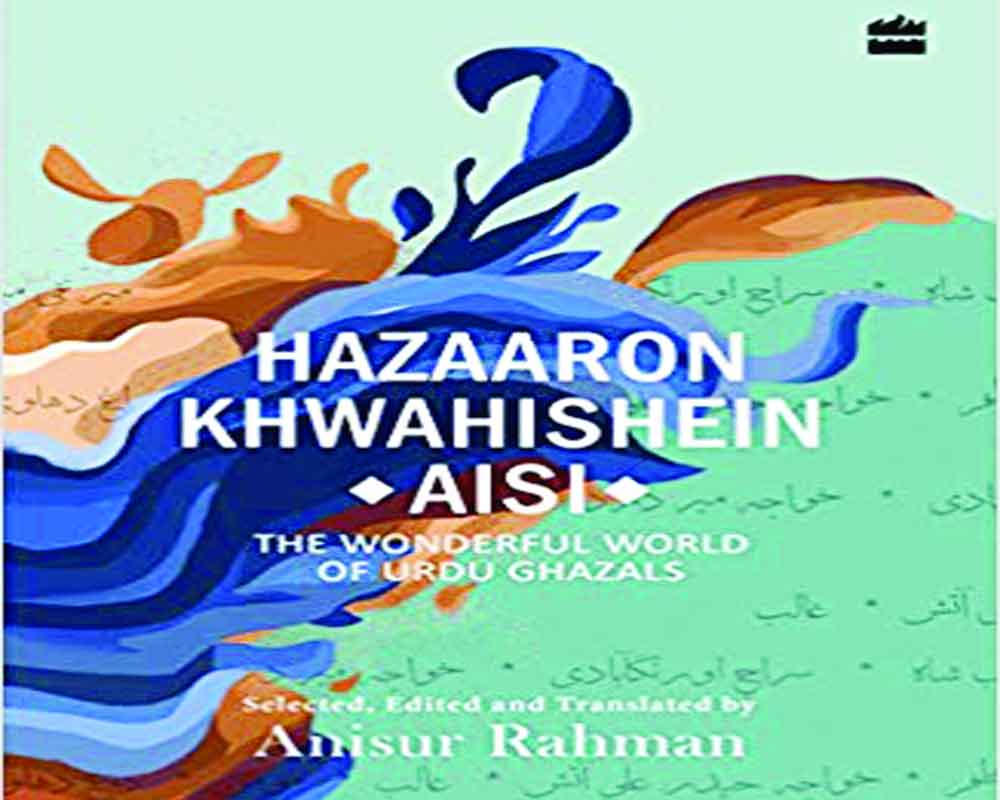HAZaARON KHWAHISHEIN AISI
Author : Anisur Rahman
Publisher : HarperCollins, Rs 599
Ghazal has more to offer, this book tells us, than just laments of lovelorn bohemians. It can accommodate contemporary and polemical subject matters too. Prof Rahman excels both as a translator and trans-creator, says Avantika Pokhriyal
Hazaaron Khwahishein Aisi is a book that is meant to be savoured leisurely, much like its subject matter — the ghazal. In spite of being a popular form in its heydays, the ghazal has now become associated with connoisseurs of art and a niche audience and has consequently moved away from the masses. The politicking around languages, which were the cup-bearers of the poetic form, has done little to ameliorate the situation. This book, however, has made the subject accessible for lay readers without compromising on the nuances and complexities of the poetic form.
Prof Anisur Rahman, who I had the good fortune of having as my teacher, has translated each ghazal into English with an air of effortless ease that belies the meticulous attention to detail involved in such a task. The book has been prefaced with a detailed introduction which delineates the simultaneously exciting as well as turbulent historical journey of the ghazal all over Eurasia.
Originating in Arabia, the ghazal gained popularity in countries like Spain and even Germany, where philosophers and writers, including Friedrich Schlegal and Wolfgang Goethe, wrote various volumes of German ghazals. The conversational tone of the editor transports the reader across historical epochs, almost seamlessly. The book inculcates an appreciation of the literary form in the readers without being heavy-handed or launching into effusive praise about the ghazal — as many other books on the subject matter tend to do.
The book has been divided into various sections, namely: ‘Metaphysical Beginnings’, ‘Towards Enlightenment’, ‘Advent of Modernism’ and ‘Beyond New Poetics’, in order to elucidate the changing dynamics at the socio-cultural level and the corresponding shifts in the thematic preoccupations of the practitioners of the form. Thus, various poets have appropriated the form according to their own context and personal predilections. Prof Rahman has maintained his lucid style even when explaining the technicalities of the ghazal such as its refrain (radeef), rhyming words (qaafia) and other structural details.
Rather than being an intensive study of the form, as it flourished in one age or under a particular poet, Hazaaron Khwahishein Aisi gives a broad overview of the thematic and historical trajectory of the ghazal, beginning from the time of Muhammad Quli Shah, a poet of the 5th century, to the late 20th and early 21st century, where a ‘New Poetics’ is being threshed by contemporary poets, such as Farhat Ehsas and Ishrat Afreen, to name a few.
This means that the uninitiated reader can appreciate the thematic flexibility and historical resilience of the ghazal. The ghazal has persisted in spite of political and/or religious hostilities, massive changes in power structures and even formal innovations as well as intrusions. But it has managed to consistently find readers and listeners across the globe from the time of its inception in Arabia, in the early 8th century, till date.
Although today it is most commonly identified with love poetry (after all, the word ‘ghazal’ means ‘talking to the lady love’), owing largely to its representation in popular culture, especially cinema, the ghazal is far from being apolitical. The perception of ghazal gatherings as being only about the hobnobbing of wine-drinking elitists is rather misleading, if not entirely false. The ghazal has more to offer, the book tells us, than just laments of lovelorn bohemians. It can accommodate contemporary and polemical subject matters. The increasing resistance by women writers in developing societies against the perennial problem of gendered violence born out of patriarchal oppression has been captured in the ghazal, “Ladkiyaan maaon jaise muqaddar kyu rakhti hain?” (“Why do girls share fates with their mothers?”) by Afreen. It is a poignant rendering of the sexual and physical violence women have to bear. The following sher is noteworthy: “Auratein apne dukh ki virasat kisko dengi/Sandook mein bund ye zewar kyu rakhti hain?” (“Who would these women make the lasting heirs of their pain/Why do they keep gems and jewels hidden in a vault?”)
It speaks to women across the globe, irrespective of political boundaries, and is as true of India as it might be of anywhere else in the world where a large section of society has to battle on an everyday basis in order to get equal opportunities. It is heartening to see a woman appropriate the ghazal — which has long been the purview of male poets like Ghalib and Mir — to register her dissent against gender politics.
The English translation of each of the ghazals maintains the layered texture of the original. Prof Rahman has retained the formal brevity and compactness of the ghazals while also being able to maintain the multiple meanings of each verse through the use of allusions and imagery. The titular sher, by Asadullah Khan Ghalib, is a perfect example of the same: “Hazaaron khwahishein aisi ke har khwahish par dam nikle/Bahut nikle mere armaan lekin phir bhi kam nikle.” Prof Rahman translates it as: “Desires in thousands I had, for each I would die/With many I had luck, for many I would sigh.”
The painstaking attention to detail makes him a good translator and a commendable poet. Prof Rahman excels both as a translator and trans-creator. This is a book for all seasons and all moods — be it pensive and ruminative or effervescent and buoyant.


























